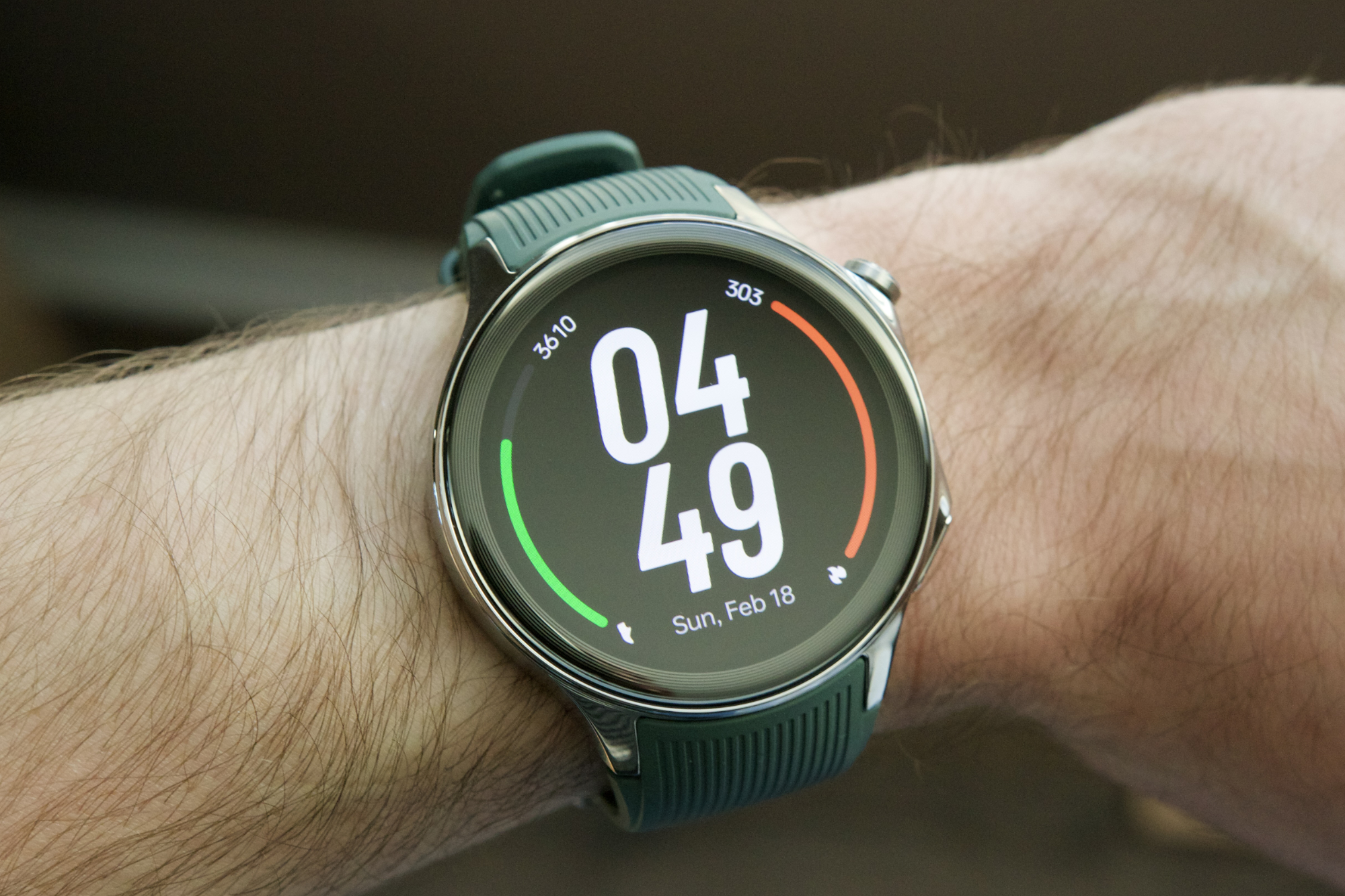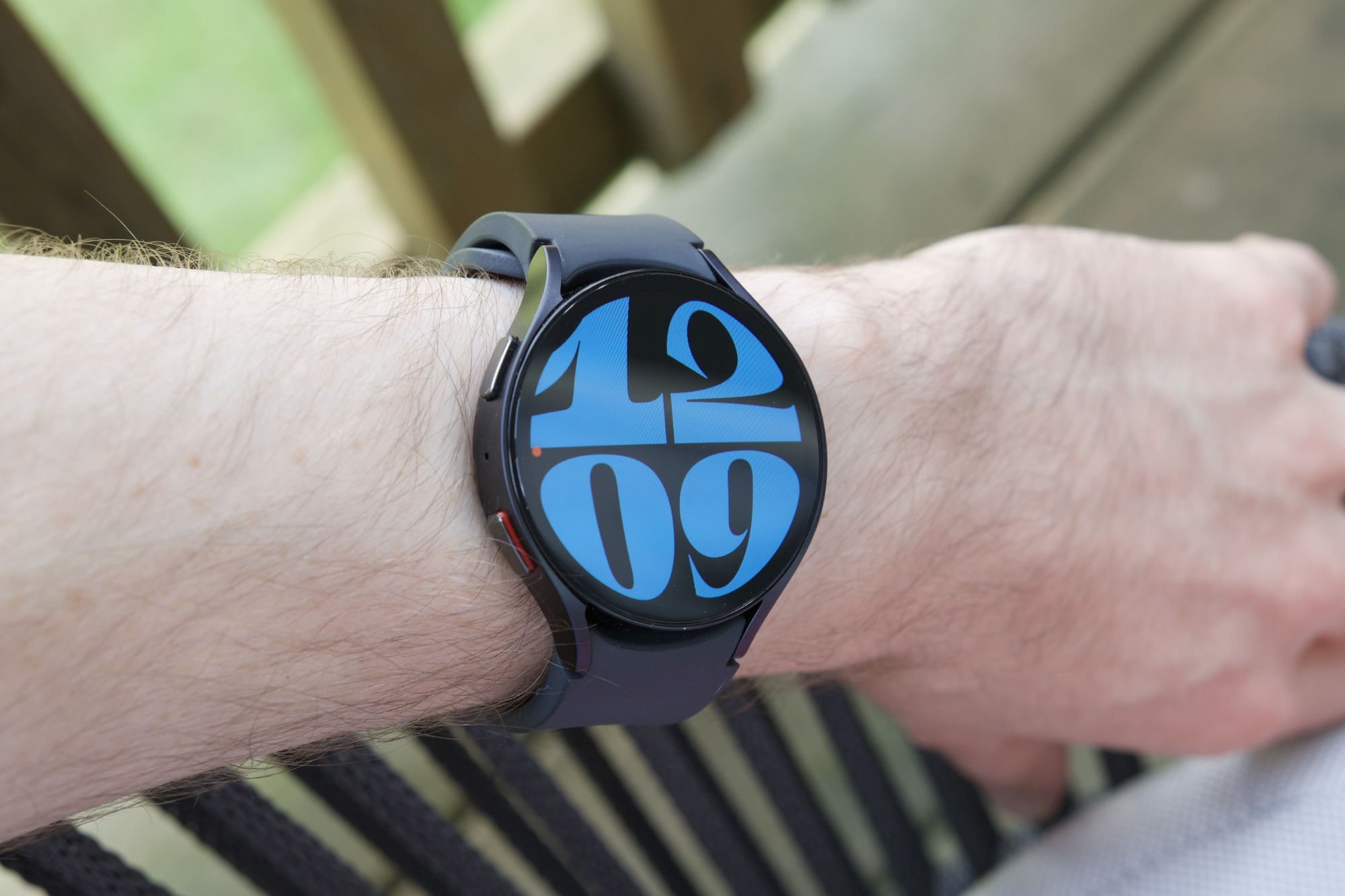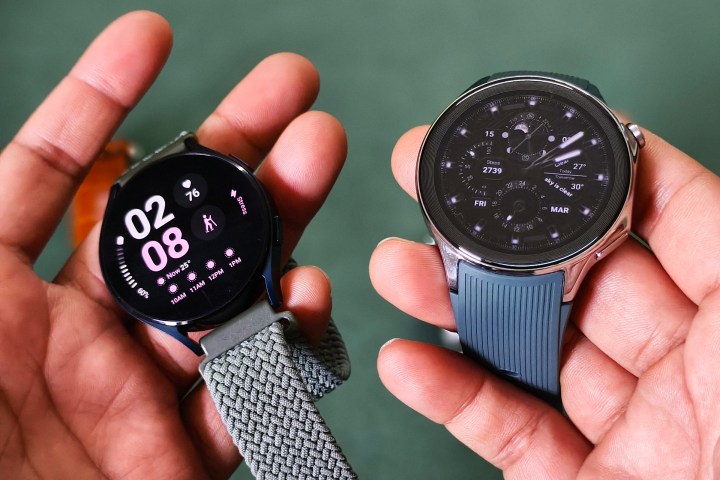
OnePlus has found a unique niche in the smartphone business with a venerable lineup of impressive Android phones. While OnePlus has occasionally stumbled, for the most part, it has produced a consistently strong smartphone lineup.
- OnePlus Watch 2 vs. Galaxy Watch 6: specs
- OnePlus Watch 2 vs. Samsung Galaxy Watch 6: design
- OnePlus Watch 2 vs. Galaxy Watch 6: display
- OnePlus Watch 2 vs. Galaxy Watch 6: performance
- OnePlus Watch 2 vs. Galaxy Watch 6: software and features
- OnePlus Watch 2 vs. Galaxy Watch 6: battery life and charging
- OnePlus Watch 2 vs. Galaxy Watch 6: fitness and health tracking
- OnePlus Watch 2 vs. Galaxy Watch 6: price and availability
- OnePlus Watch 2 vs. Galaxy Watch 6: verdict
However, the same can’t be said of its attempt to break into the smartwatch market. The original OnePlus Watch released in 2021 was a bold attempt at longevity and classy design that fell flat in too many other areas to make it even a marginal success.
After nearly three years of silence, OnePlus recently returned with a second attempt: the OnePlus Watch 2. The new model seems to retain the same priorities as its predecessor — top-notch design and long battery life — but tries to fill in the missing pieces by adopting Wear OS 4.
OnePlus is clearly hoping that the second time will be a charm, but can the OnePlus Watch 2 compete with Samsung’s Galaxy Watch 6, which has become the standard against which nearly every other
OnePlus Watch 2 vs. Galaxy Watch 6: specs
| OnePlus Watch 2 | Samsung Galaxy Watch 6 | |
| Display size | 1.43 inches | 40mm: 1.3 inches
44mm: 1.53 inches |
| Body size | 47mm | 40mm
44mm |
| Weight | 49 grams | 40mm: 28.7 grams
44mm: 33.3 grams |
| Resolution in pixels | 466 x 466 (326 pixels per inch) | 40mm: 432 x 432 (453 ppi)
44mm: 480 x 480 (453 ppi) |
| Touchscreen | AMOLED | Super AMOLED, always-on display |
| Storage | 32GB | 16GB |
| Wireless interface | Bluetooth 5.0, Wi-Fi 802.11 a/b/g/n dual-band, |
Bluetooth 5.3, Wi-Fi 802.11 b/g/n, dual-band, |
| Depth | 13.65mm | 0.35 inches (9mm) |
| Blood oxygen sensor |
Yes | Yes |
| Accelerometer | Yes | Yes |
| Gyroscope | Yes | Yes |
| Ambient light sensor | Yes | Yes |
| Heart rate sensor | Yes | Yes |
| Barometer | Yes | Yes |
| GPS | Dual Frequency L1+L5 | Single Frequency L1 |
| Compass | Yes | Yes |
| Water/dust resistant | MIL-STD-810H, 5ATM, IP68 | MIL-STD-810H, 5ATM, IP68 |
| Battery life | Up to 100 hours in Smart Mode; up to 12 days in Power Saver mode | Up to 24 hours |
| Price | From $300 | From $300 |
OnePlus Watch 2 vs. Samsung Galaxy Watch 6: design
If there’s one thing that stands out about the OnePlus Watch 2, it’s the design. OnePlus has hit the right notes in producing a smartwatch that looks “smart” in the fashion sense rather than merely the technological one.
The stainless steel body and sapphire crystal give the OnePlus wearable both flair and durability. The Radiant Steel version is polished and shiny, while the Black Steel is darker and slightly more matte without losing its reflectivity.
This adds up to a noticeably classier look compared to Samsung’s Galaxy Watch 6, which, although it features a very similar design, has a more utilitarian aesthetic with its matte aluminum finish. There’s also a rotating crown here to contribute to that look, but sadly, it’s almost entirely decorative. In an altogether baffling design decision, OnePlus chose to make it spin without actually having it do anything, making it little more than an ornamental button.
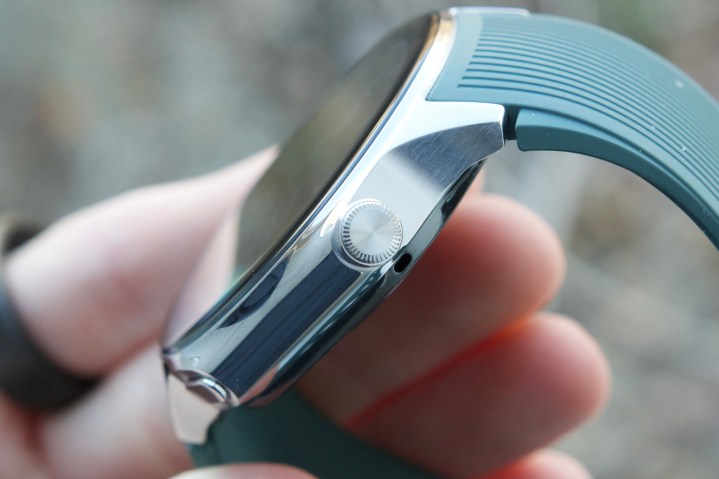
While the stainless steel design of the OnePlus Watch 2 makes it heavier (it weighs 49 grams without the strap compared to the 33 grams of Samsung’s largest Watch 6 model), we didn’t find those extra 16 grams made a noticeable difference in comfort, even when wearing the OnePlus Watch 2 to bed every night. OnePlus has also managed to keep its weight down compared to other stainless steel wearables — it’s 10 grams less than the similarly sized stainless steel Galaxy Watch 6 Classic.
It’s also worth keeping in mind that your choice of watch band could make more of a difference here. OnePlus’ standard band adds 31 grams, bringing the total weight to 80 grams, while Samsung’s standard Galaxy Watch 6 sport band weighs 23 grams, depending on size, and its lightweight fabric band is just under 10 grams.
You’ll have plenty of options to choose from if you want to change up your strap, as both the OnePlus Watch 2 and Galaxy Watch 6 feature removable band systems. Although the popularity of Samsung’s smartwatches means that you’ll find more watch bands advertising Watch 6 compatibility, the OnePlus Watch 2 features a standard 22mm quick-release mechanism, making it compatible with bands made for the Galaxy Watch 3 and others that use the 22mm attachment.
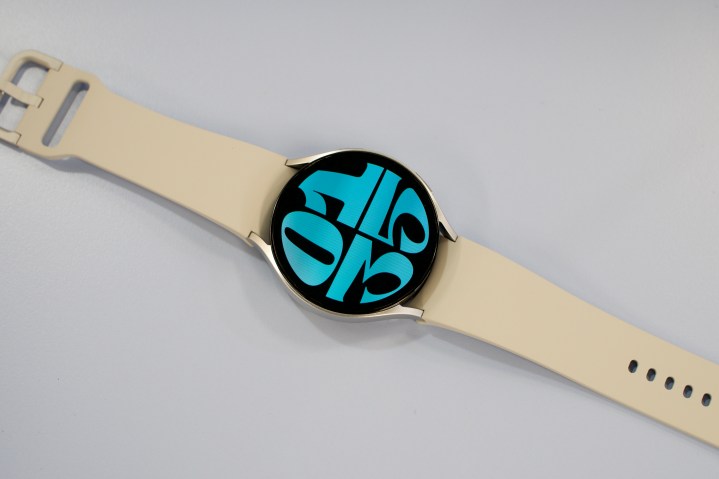
The OnePlus Watch 2 and Galaxy Watch 6 are evenly matched when it comes to ruggedness. Both feature a military-grade MIL-STD-810H durability rating and 5 ATM and IP68 dust and water resistance. That means either will survive immersion in up to 1.5 meters of fresh water for up to 30 minutes or 50 meters for up to 10 minutes. Both also feature displays made from sapphire glass that should be highly resistant to scratches.
Anyone used to other smartwatch platforms may find the nonfunctional rotating crown a frustrating omission, but the OnePlus Watch 2 gets so many other things right with its design that it may be worth living with that little bit of weirdness. It looks great while being shockingly lightweight and comfortable given its size and use of stainless steel materials. However, that’s not to say that the Galaxy Watch 6 doesn’t stand out in its own right. For one thing, you have two sizes to choose from, and we think many folks will appreciate the subtler aesthetic. The decision between these two is an entirely subjective one, so we have to call it a tie.
Winner: Tie
OnePlus Watch 2 vs. Galaxy Watch 6: display
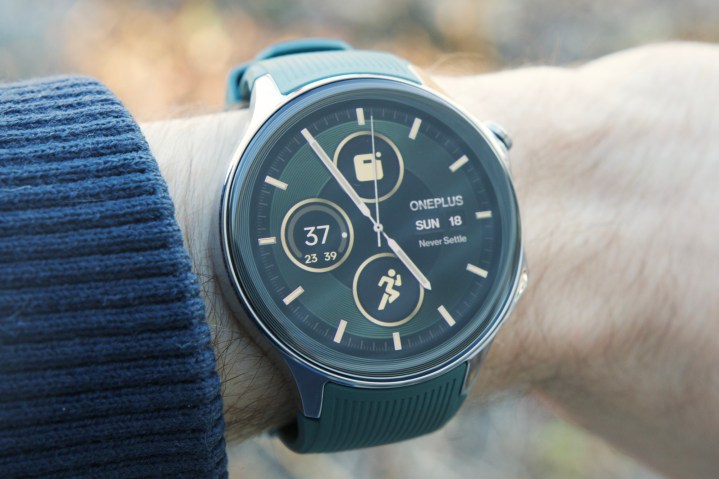
The OnePlus Watch 2 packs in a 1.43-inch AMOLED panel with a resolution of 466 x 466. That works out to a density of 326 pixels per inch (ppi), and even though that falls short of Samsung’s 453 ppi, OnePlus still manages to keep everything looking remarkably crisp and vibrant.
However, Samsung still edges it out not only in pixel density, but also in brightness: the Galaxy Watch 6 can now hit 2,000 nits compared to 600 on the OnePlus Watch 2. That’s a significant difference on paper, but it’s worth mentioning that we never had an issue seeing the OnePlus Watch 2 outdoors in bright sunlight. The Galaxy Watch 6 may do better when the sun is bearing right down on it, but the OnePlus Watch 2 is no slouch.

The Galaxy Watch 6 also offers a slightly larger screen in a smaller casing thanks to thinner bezels; the 44mm model features a 1.53-inch screen, while the screen on the 40mm model measures 1.3 inches, and both feature the same higher pixel density.
These are small differences, and we don’t think anybody will be disappointed with the display on the OnePlus Watch 2, but the Galaxy Watch 6 still edges it out with its brighter screen and better use of space on the frontage.
Winner: Galaxy Watch 6
OnePlus Watch 2 vs. Galaxy Watch 6: performance
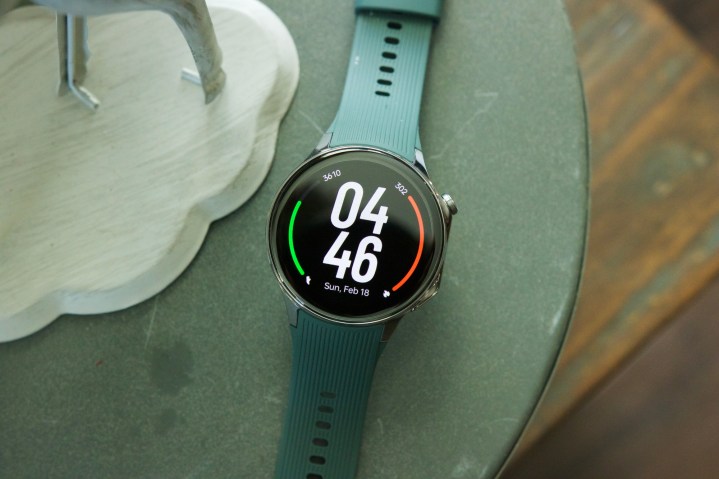
The OnePlus Watch 2 is powered by Qualcomm’s Snapdragon W5 Gen 1 chip, so it’s no surprise that it offers buttery-smooth performance, from opening apps to navigating through menus and tiles.
We would have liked to have seen Samsung adopt Qualcomm’s platform for the Galaxy Watch 6, but sadly, the company has stuck with its own in-house Exynos W930. That’s a dual-core chip with a clock speed of 1.4GHz, but it still falls short of the W5’s quad-core 1.7GHz configuration.
That’s not to say the Galaxy Watch 6 performs poorly — we’ve never felt that it lags or struggles to keep up with us when opening apps or scrolling — but it’s unquestionably a bit more sluggish than other top-tier smartwatches.
Samsung may have shied away from the Snapdragon W5 for the sake of energy efficiency, but OnePlus took a more creative approach to that problem. Instead of saddling its wearable with a less powerful chip, it added a BES 2700 efficiency co-processor to handle everyday tasks, reserving the W5 for only those tasks that need the extra performance. It works so well that you’ll have no idea when it’s switching chips behind the scenes, and it allows the OnePlus Watch 2 to deliver incredible battery life without compromising performance. We’ll talk more about that later.
Winner: OnePlus Watch 2
OnePlus Watch 2 vs. Galaxy Watch 6: software and features

The OnePlus Watch 2 has been a refreshing change from its predecessor, as it has mostly ditched the proprietary RTOS operating system and joining the brotherhood of Wear OS smartwatches.
Specifically, the OnePlus Watch 2 runs Wear OS 4, and it runs pretty much like any other smartwatch in that regard. Sadly, OnePlus’ implementation isn’t without its quirks, not the least of which is the awkwardly useless rotating crown we mentioned earlier. Navigating the OnePlus Watch 2 will require you to resort to swiping on the touchscreen to get around. You still need to press the crown button to view all your apps, but rotating it doesn’t do what you might expect, which is to say, anything at all.
OnePlus has added some of its own tweaks to Wear OS 4, although it doesn’t go so far as to call it a different skin the way Samsung does with One UI 5.0. Instead, you get smaller tweaks, many of which feel like they were inspired by Apple’s watchOS. OnePlus also has a collection of watch faces, but none of them are anything to write home about, which feels like a big miss considering the wearable’s outstanding hardware design.
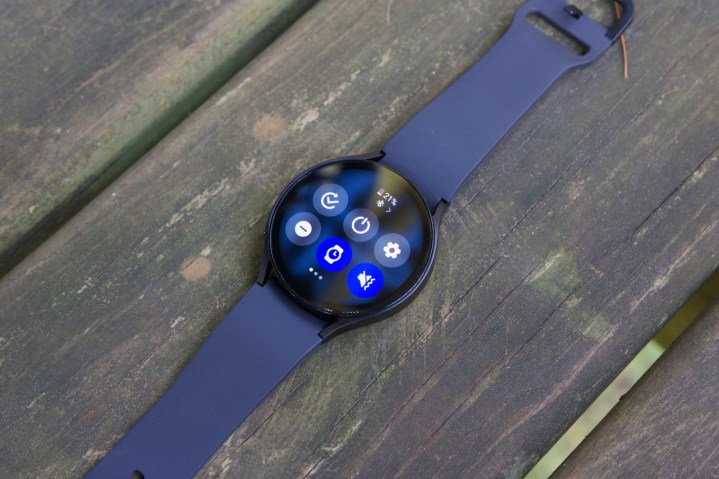
We also found parts of the experience to be a bit glitchy, encountering things like unreliable notifications. That’s a problem we’ve also encountered on other Wear OS devices, so it’s hard to point the finger too much at OnePlus here. However, Samsung has managed to get it right on the Galaxy Watch 6, where notifications have proven reliable in our testing and are also more configurable thanks to One UI.
Although the OnePlus Watch 2 primarily runs Wear OS, the company hasn’t eliminated RTOS from the mix. Instead, it cleverly uses the more efficient, but limited OS to provide a Power Saver mode that lets it sip battery life. RTOS has been seamlessly integrated into the system in such a way that you won’t notice much of a difference; enabling Power Saver doesn’t change the user interface, and all of the built-in functions like health and fitness, weather, alarms, timers, and notifications will continue to work. However, since Wear OS is shut down in that mode, you won’t get to run Wear OS apps or call up Google Assistant. The always-on display is also disabled, but we suspect that’s more about saving power than a limitation of RTOS compared to Wear OS.
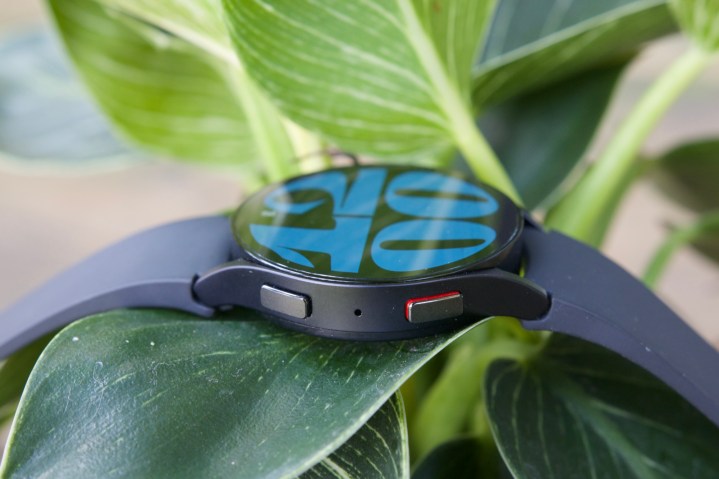
The Galaxy Watch 6 does have one other trick up its sleeve: It offers a 4G/LTE version for those who want to stay connected even when they leave their phone behind. The OnePlus Watch 2 doesn’t offer a cellular version, so if that’s important to you, the Galaxy Watch 6 will be your only choice.
This one is a closer race. OnePlus has done some interesting things here and scores a few points for its clever use of Wear OS and RTOS together. However, it also has a few quirks that make it feel like a first-generation implementation. While we’re optimistic that OnePlus will get there, Samsung’s more mature and established One UI 5.0 gives the Galaxy Watch 6 a meaningful edge for those looking for a more polished user experience.
Winner: Galaxy Watch 6
OnePlus Watch 2 vs. Galaxy Watch 6: battery life and charging
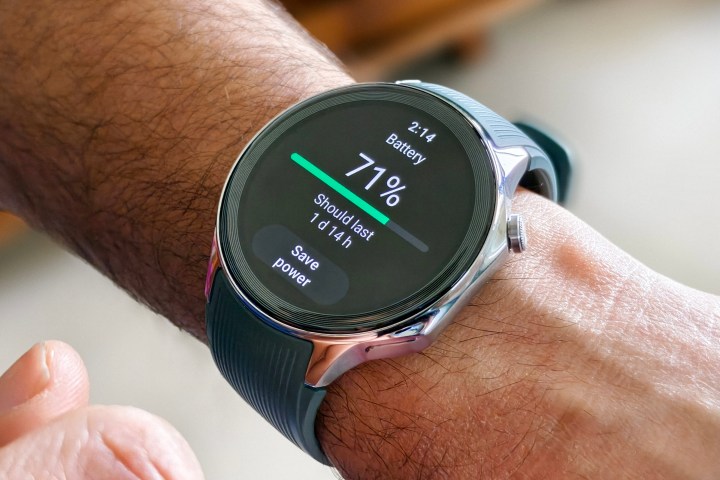
OnePlus’ phones have always been leaders when it comes to battery life and charging performance, and as we’ve already touched on in previous sections, the company has brought some of those same qualities to its second-generation wearable.
The OnePlus Watch 2 packs in a 500mAh battery that boasts up to 100 hours of battery life in “Smart Mode.” The company describes this as using an officially supported watch face with the always-on display turned off, the default health monitoring configuration, a persistent Bluetooth mobile phone connection with less than one hour per day of standalone Wi-Fi usage, 6.5 hours of sleep monitoring per night, 30 minutes of outdoor running per day, 130 notifications, five minutes of Bluetooth calling, and 15 minutes of headset listening on Spotify per day.
Other than leaving the always-on display off, that’s a reasonably generous usage model. While 100 hours between charges seems unbelievable, it might not be far off. In practical terms, most folks should easily be able to get three full days of battery life without disabling the always-on display.
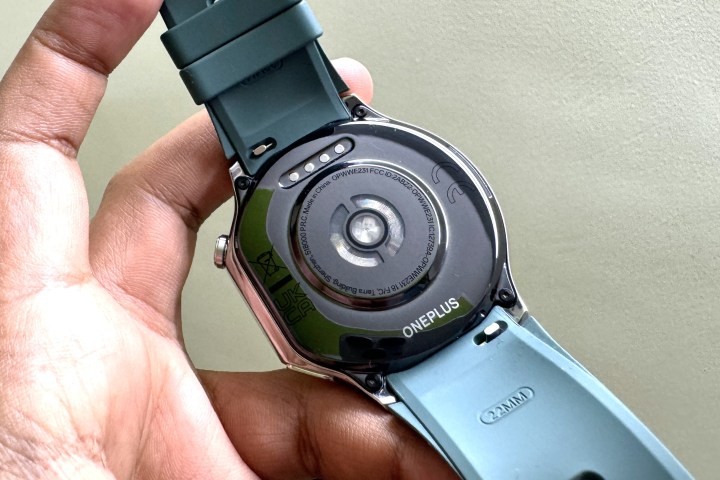
In our testing, the OnePlus Watch 2 still had 13% battery life after more than 61 hours of constant use, including overnight sleep tracking, outdoor walks, and a steady stream of notifications, all with the always-on display enabled the whole time.
For some context, OnePlus also lists a “heavy use” model that promises 48 hours of battery life. This includes leaving the always-on display enabled and operating with a third-party watch face that requires the more power-hungry Snapdragon W5 performance chipset to be engaged. This also factors in two hours per day of Wi-Fi usage, plus more notifications, increased screen time, 30 minutes per day of outdoor running with the GPS enabled, and 30 minutes of listening to Spotify over Bluetooth.
In either case, that’s incredible battery life by Wear OS standards. However, OnePlus has taken things one step further with a Power Saver mode that promises up to 12 days between charges. As we mentioned earlier, this mode switches off the Wear OS features, so you’ll only be able to use the built-in apps. However, you can still use it for 90 minutes of outdoor exercise per week and continue to receive alarms, calls, and notifications on your wrist.
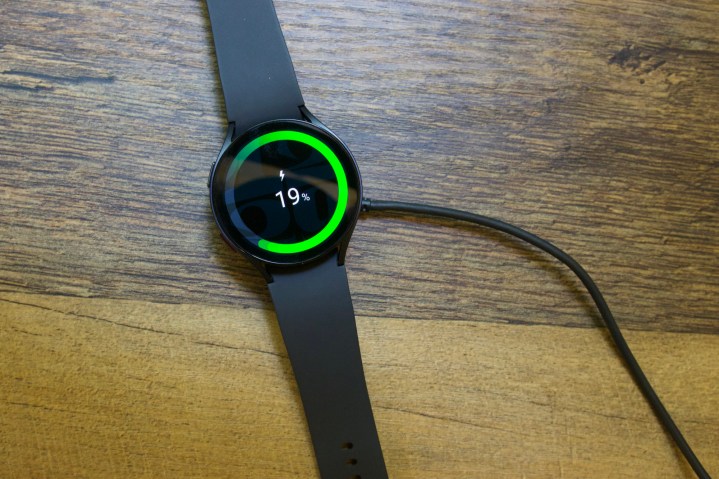
Although Samsung improved the battery life of the Galaxy Watch 6 over its predecessor, it still can’t hold a candle to what OnePlus is offering here. Samsung promises 40 to 50 hours of use per charge, but in our experience, you’ll likely need to hit the charger after two full days if you use the sleep-tracking features. You can squeeze a bit more out of the Galaxy Watch 6 by turning off higher-power features like the always-on display, but there’s no equivalent to OnePlus’ Power Saver mode here.
Both watches are more on par when it comes to charging. The OnePlus Watch 2 features 7.5-watt fast charging that can deliver 24 hours of power after a 10-minute charge and top it up to 100% in 60 minutes. We found it could go from 13% to 75% in about 20 minutes. The charging puck also has a thoughtful design, with a detachable USB-C cable that makes it much nicer for travelers.
By comparison, the Galaxy Watch 6 uses a 10-watt charger that doesn’t noticeably charge the wearable faster. You’ll get up to 45% after about 30 minutes, but it takes a little over an hour to reach a full charge.
Basically, you’ll be able to charge up both watches in about the same amount of time, but the outstanding battery life on the OnePlus Watch 2 means you won’t need to it nearly as often.
Winner: OnePlus Watch 2
OnePlus Watch 2 vs. Galaxy Watch 6: fitness and health tracking
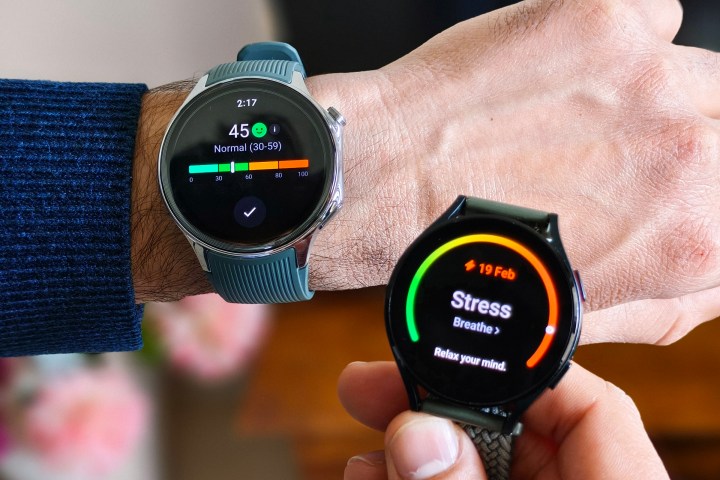
If there’s one area the OnePlus Watch 2 really falls behind against its competitors it’s in the health and fitness features. Although the wearable offers all the tools you’d expect — including heart rate and activity tracking, stress monitoring, sleep tracking, and even a blood oxygen sensor — we found that it suffers from some potentially serious inaccuracies and a few other odd quirks.
The health features work well enough at a basic level, with a Daily Activity app on the Watch 2 joined by OnePlus’ OHealth app on your
The health apps don’t offer much in the way of frills. You won’t see awards, challenges, guided meditations, or social features, but they get the job done — or at least they should.
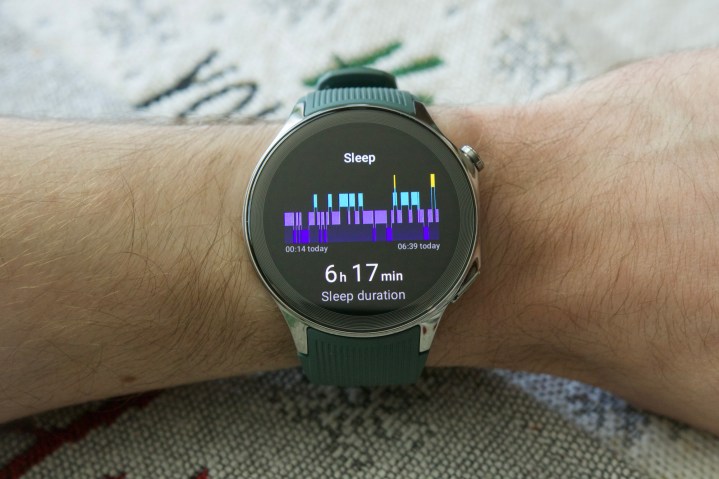
The problem is that our testing showed the numbers for step and sleep tracking to be woefully inaccurate compared to those measured by other smart devices. Steps were off by 3,000 to 4,000 compared to what an Oura Ring recorded, and sleep stages were similarly way off, with the OnePlus Watch 2 barely recording “awake” time at all and significantly overstating light and REM sleep durations. That won’t be a deal breaker for folks who just like to have a general feel for these numbers, but it’s a serious problem for those who prefer accuracy in their smart devices.
The Daily Activity app on the OnePlus Watch 2 also offers a weird metric where it’s trying to measure something in relation to quantities of food (e.g., 1.8 lattes or 1.1 pieces of fried chicken), but it’s not clear exactly what it’s trying to say, and some folks might even find it a bit off-putting. We certainly did.
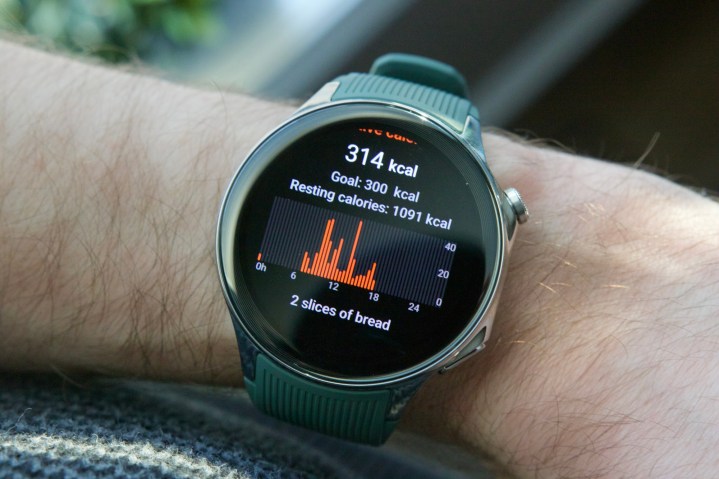
This is where Samsung shows its longer and more refined health experience with the Galaxy Watch 6. Samsung’s Health platform not only offers more accurate metrics, but also features Advanced Sleep Coaching and Personalized Heart Rate Zones to help improve your health and fitness.
These join Samsung’s extensive collection of long-running health features like heart rate monitoring, automatic workout detection, cycle tracking, blood oxygen tracking, and an ECG app. Plus, the Bioelectrical Impedance Analysis (BIA) and temperature sensors can track your body’s muscle composition, water percentage, body temperature, and more.

In fact, the Galaxy Watch 6 packs in so many different health features that it can be a bit intimidating. But everything works as a seamless package, and it’s easy to tailor to your specific needs. The only real downside is that Samsung throws a lot of information at you, but doesn’t do a great job of explaining what any of it means, leaving those of us who aren’t medical professionals or fitness experts to do our own research.
The really good news here is that both OnePlus and Samsung offer their health features for free, with no annoying subscriptions required. We think “free” is the right price for what the OnePlus Watch 2 offers, but you’re definitely getting a great deal with everything that Samsung Health is capable of on the Galaxy Watch 6.
Winner: Galaxy Watch 6
OnePlus Watch 2 vs. Galaxy Watch 6: price and availability
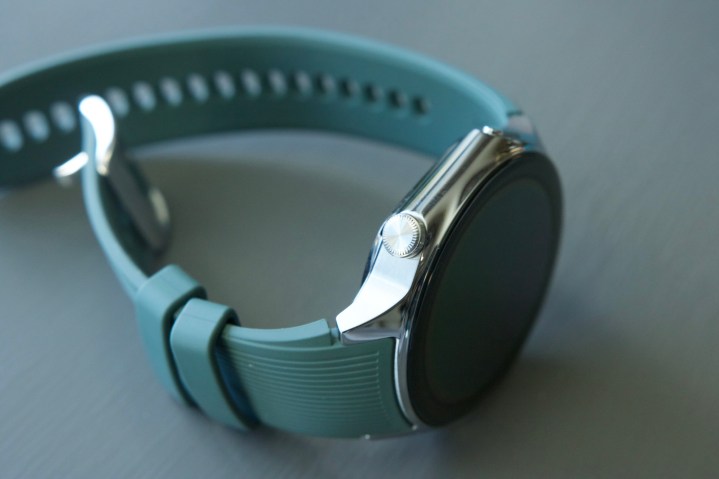
The OnePlus Watch 2 can be purchased for $300 from Amazon or directly from the OnePlus website. When ordering from OnePlus, you can get a discount of $50 or more by trading in any watch — not just a smartwatch — in any condition. The OnePlus Watch 2 comes in Radiant Steel with a green/blue watch band or Black Steel with a black watch band.
Samsung’s Galaxy Watch 6 starts at the same $300 price for the 40mm model or $330 for the 44mm model. Adding 4G/LTE connectivity will add $50 to each of those prices. Unlike the OnePlus Watch 2, you’ll be able to find the Galaxy Watch 6 at most major retailers, both online and offline, though you’re more likely to be able to pick up the 4G/LTE versions from your carrier (possibly on a promo).
Color options are a bit trickier with the Galaxy Watch 6, as graphite is the only color available in both sizes. Those who prefer gold will have to opt for the 40mm Watch 6, while silver is exclusive to the 44mm version. The Galaxy Watch 6 is packaged with a matching sport band at most retailers, although multiple band options are available when ordering directly from Samsung.
OnePlus Watch 2 vs. Galaxy Watch 6: verdict

As we noted in our review, the OnePlus Watch 2 is a strange mixed bag of great successes and perplexing shortcomings. It was a tough smartwatch to review, and it’s an even harder one to recommend.
There’s a solid list of things that OnePlus got right here, including an excellent design with premium materials, insanely great battery life, and top-tier performance. That may be a short list, but it’s an impressive one.
On the other hand, it falls short in so many other areas, including weak and inaccurate health features, slightly quirky software, and a poor collection of watch faces. The non-functioning crown may not sound like a serious problem on its own, but it makes the entire user experience feel just a little off.
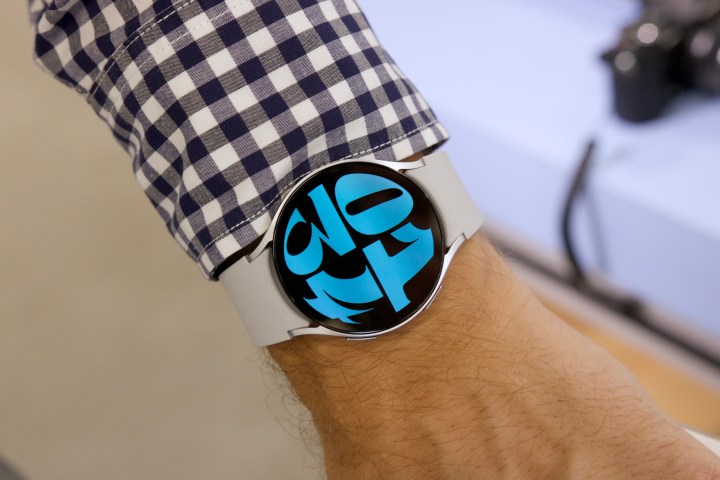
Like OnePlus’
However, we think most folks will be far better served by the Galaxy Watch 6. Samsung’s One UI software platform has had time to get much more mature and polished, and while its designs may be more pedestrian, they’re still stylish, and you get two different sizes to choose from. Samsung’s Health features are miles ahead of what OnePlus is offering, and the battery life is more than adequate for most folks.
Editors' Recommendations
- The best Android tablets in 2024: the 11 best ones you can buy
- The OnePlus 12R is still one of 2024’s best smartphone deals
- Every Android tablet we’re expecting in 2024
- This deal gets you a box-fresh Samsung Galaxy Watch from $99
- The OnePlus 12 is the OnePlus phone I’ve been waiting for

